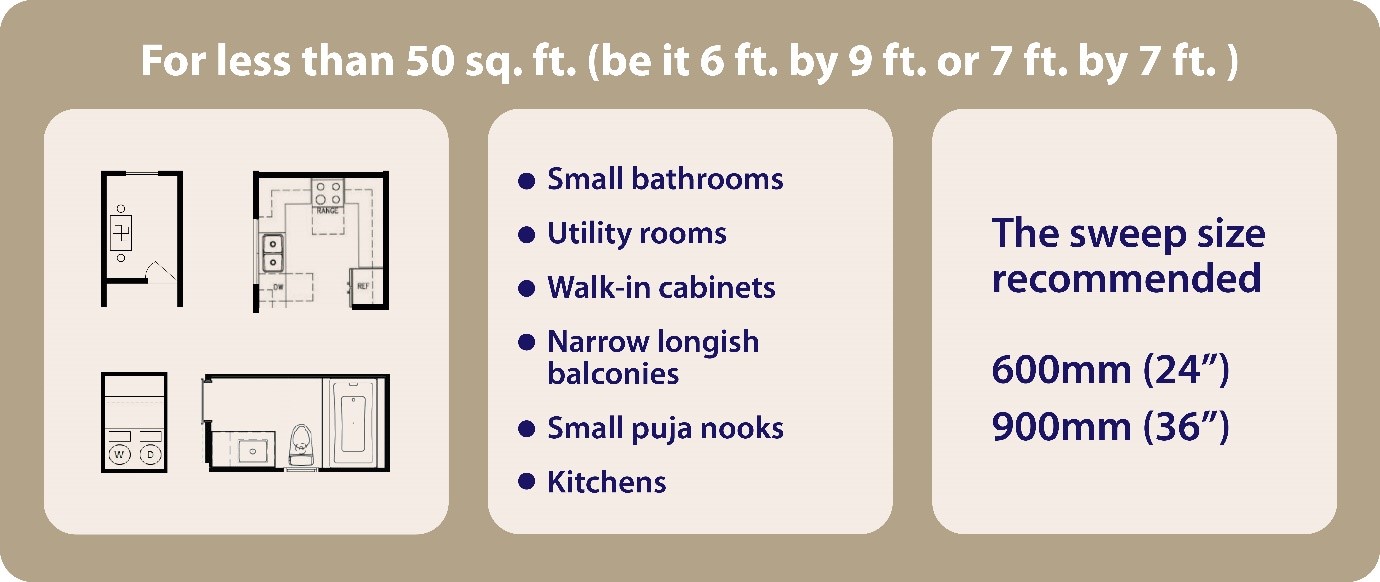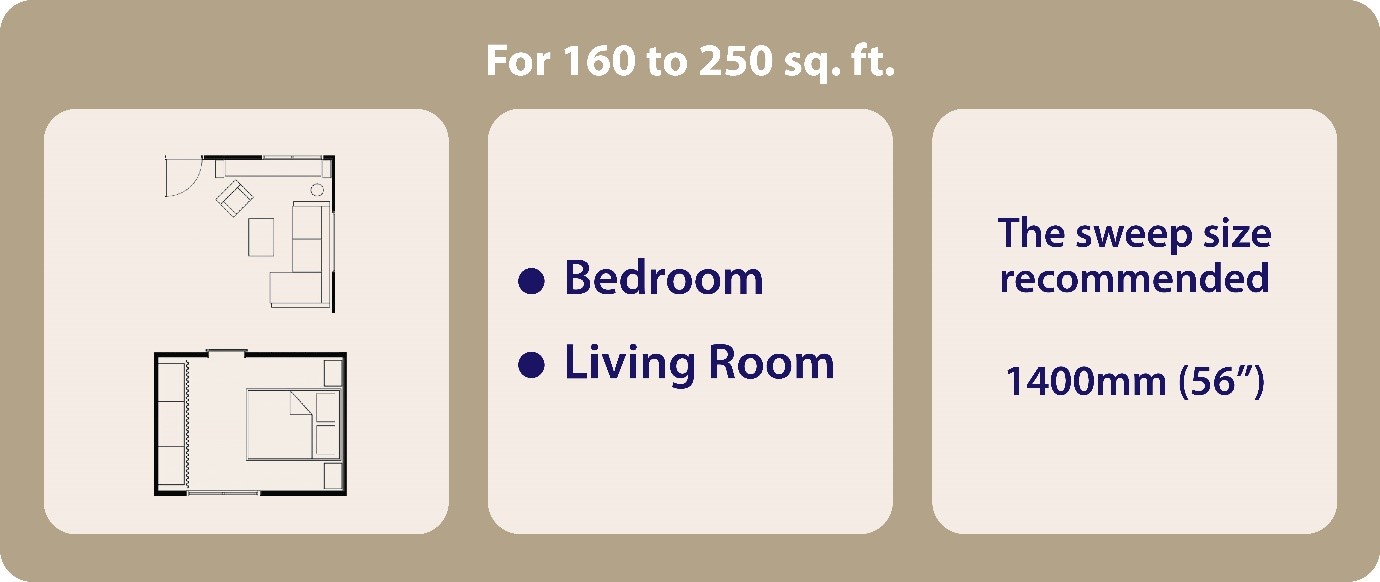Ceiling fans are designed based on operating conditions of the environment of a particular place. In a hot and humid country like India, the central purpose of an electric fan is to create airflow and deliver a cooling effect.
So, what exactly do 4-5 bladed fans do? Do more blades increase the airflow? Are these better than three-bladed ones?
Let’s find out.
In India, ceiling fans are usually stand-alone appliances to generate cooling comfort in hot and humid weather conditions. Although air conditioners have gained traction in places with scorching temperatures, ceiling fans have not lost their importance even in today’s time.
The Indian Ceiling fan industry is on the advent of a huge revolution. With the new mandatory Star Rating regime soon to be implemented by the Bureau of Energy Efficiency (BEE), the face of the industry will undergo a distinct makeover. Before the fan industry, numerous other product industries in India have been at the same juncture. With energy conservation being a global mantra and India being committed to the cause, its various industries have made their contribution by creating and promoting products which save power for the consumer and the country.
While a changeover of this nature at an industry level is always challenging for all players involved, it is a significantly tougher task this time for the Indian fan industry. The magnitude of the change that the industry will go through can be gauged by the fact that 95% of the Ceiling fans which are sold today by the industry do not qualify for even a 1 Star rating under the revised norms of the BEE. Therein lies the challenge, but with challenges there always come opportunities.
At the heart of a Ceiling fan lies the motor, and it is this motor which decides how efficiently a fan performs. The new era of efficiency calls for a much more efficient motor at the heart of the fan; and for many, the answer lies in the new technology called Brushless Direct Current or BLDC Motor. This technology comes bearing fruits like 50% less power consumption and consistent performance across a large voltage range, resulting in a sure shot way to a 5 Star BEE Rating. While there is no doubt on the positives that this technology provides, the ride for adoption of BLDC will not be as smooth as it appears to be.
The BLDC Motor technology depends on an electronic controller and permanent magnets. With the ongoing global crisis for electronic parts and the selective geographical availability of magnets, the industry will not be able to convert a large part of its offerings into BLDC motors, even if it wants to. Then there is the issue of cost. The BLDC motor currently costs 2.5x-3x of current fan motor costs and the aforementioned factors are not going to make costs softer in the foreseeable future. While the Indian consumer is conscious of energy efficiency and this warrants more efficient products; they may not be ready to and, in a lot of cases, may not even have the ability to pay a significant premium to adopt them. Therefore, the Ceiling Fan product range will have to depend on the old war horse which has carried its load for more than half a century – the Induction Motor.
It was believed for a long time that the fan industry had achieved a high level efficiency with the induction motor. After all, this motor was performing admirably to address the dual needs of high air delivery at an affordable cost for the tropical but not so affluent Indian consumer. But with the exigent situation that the industry faces today, the brightest minds in this trade have challenged themselves and are bringing out levels of efficiency which were previously unheard of and thought to be unachievable by the humble induction motor. As of this time, engineers of the industry have been able to develop induction motors for Ceiling Fans which provide up to 40% energy saving at a cost delta which is significantly lesser than that of the BLDC motor.
While BLDC is undoubtedly the future of motor technologies for fans, I do not believe that the induction motor has run its course. It is still here to stay, and with the industry putting its might and minds into making it a better performing and a more efficient device, Ceiling fans with induction motors will continue to remain the bread and butter for this industry for years to come.
As one of the nation’s premier heat transfer products firms noted in their seminars on Tier IV requirements, “Outside of the core, the fan is the most important component of the cooling package.”
Aerofoil fan blades provide efficiency and low noise using classic aerofoil design. Aerofoil fans provide uniform, high volume airflow with low power consumption for optimum efficiency using the same aerodynamics that create thrust. Aerofoil fans have a round leading edge, a sharp trailing edge, and in profile or cross section, look similar to a teardrop that has been flattened on one side. As air approaches the blade’s leading edge, the stream splits and travels above and below the blade. Air is deflected across the convex curve along the top of the blade and along the flat or concave curve on the bottom of the blade, and flows downward over the sharp trailing edge as it leaves the blade.
According to Bernoulli’s Principle, the faster moving air across the top of the blade creates less pressure than the slower moving air on the bottom of the blade. This creates lift in an airplane wing or airflow in a fan. Aerofoil fans function just like a series of small airplane wings attached to a hub, with one notable exception. In axial fans, the aerofoil’s twisted design ensures that the incident angle between the aerofoil and the airflow is constant along the blade length, giving a uniform blade loading for high efficiency, low noise fans.
Many factors have influence on designing high quality fans. Some factors are relative to fan noise. The fan noise will be controlled reasonably from the model, especially from the mechanism of fan blade shape. The optimization theory is used in the design of high-quality fans too. But every property of the fan has different weighting factors in the design and in the development stages. The fan blade shape parameters, such as the number of blades, rotational speed of fan, chord of fan, and blade profile etc. affect the Sound Pressure Level.
Following are some benefits of using aerofoil design in Fan blades :
• Increases the spread and velocity of fan blade, which helps to increase Air Delivery.
• There are no sharp edges as such, it helps to reduce noise.
• Camber in the Aerofoil helps with Air delivery with increasing pitch of the blade. Hence it reduces the torque induced to deliver same amount of air.
• In Aerofoil fans weight variation is possible as per requirement.
• Aerofoil blade fans are aesthetically better. Due to reduction in torque and noise the efficiency of Aerofoil blade fans is comparatively high then normal fan blades and gives better performance over normal fan blades.
In the modern world, where home appliances have undergone a revolution, the ceiling fan is still largely regarded as one of the best solutions for comfort during summer. This blog aims to make you aware regarding general facts and choose the right ceiling fan as per your needs.
Here is a buying guide for those who are looking for a ceiling fan in the market. The tips are given enabling you to unlock the optimum benefit from a fan.
Things to remember while buying a ceiling fan
There is an array of things that must be considered while buying ceiling fans likelike budget, intended usage, sweep size, performance, energy efficiency, aesthetics, technical details and much more. We shall take a look at all these parameters below:
SWEEP OF THE CEILING FAN REQUIRED FOR THE ROOM/SPACE
-What is the Sweep Size:
It is the length of the blade span which is the diameter of the circle that you see when the fan blades are in motion.
-Standard Sweep Sizes of fans available in India –
600mm (approx. 24 inches)
900mm (approx. 36 inches)
1050mm (approx. 42inches)
1200mm (approx. 48 inches)
1400mm (approx. 56 inches)
Some brands also have sweep sizes that are in between the above Standard Sizes. For example, 1225 mm, 1250mm,1300 mm, 1320 mm, etc. Understanding sweep sizes will help you to choose the right type based on room sizes.
Measurement and understanding of the space or room must be assessed beforehand, though.
Start with measuring the size of rooms and height of the ceiling in feet or meters. It is important to measure the distance of the side walls too. Check the ceiling hook, from which the fan is supposed to be hung. It is ideal if it is in the geometrical center of space.
Appropriate fan sweep sizes, recommended as per the room sizes:
FOR VERY SMALL SPACES
FOR SMALL SPACES
FOR NORMAL SIZE OF SPACE/ROOM
FOR BIGGER SIZE SQUARE ROOM
-For 160 to 250 sq. ft. room which is of almost square configuration- the sweep size must be 1400mm (56″).
FOR A RECTANGLE OR L-SHAPED ROOM, 2 FANS OF 1050MM (42″) OR 1200 MM (48″) SWEEP SIZE CAN BE INSTALLED
Other Important Criteria including Understanding of down rods lengths and correct distances of fan blades from floor or ceiling for optimum performance.
–Always consider one size larger fan if you are planning to install it on your veranda or balcony.
–While installing a fan in rooms with a higher ceiling, consider sweep size one level higher.
–If more fans are to be installed in a room or hall, then the optimum distance between the tips of the blades should be at least 4 feet. This will ensure no interference of the airflow from both fans.
–If the fan is to be installed close to any wall or partition, ensure that the distance of blade tip and wall or partition is at least 2 to 3 feet. This will ensure zero back suction.
–Length of the down rod is important for optimum air dispersal and maximum cooling comfort. The down rod length required depends upon the height of the ceiling of the room. For safety reasons, a ceiling fan should always hang at least 7 to 7.5 feet above the floor. However, the ideal height of blades from the floor should be 8.5-9 feet. For adequate airflow, there should be at least 9 to 10 inches of air space between the blades and the ceiling.
Different companies have different lengths of down rods. The length of down rods ranges from 220 mm (8.5inches approx.) to 275 mm (approx. 10.8 inches) for different brands. For a standard height of Ceilings, these lengths are good enough. You need to ensure that the distances from ceiling to blade level and blade level to the floor must follow as recommended above.
–For higher ceilings calculate the additional length required and buy a composite length longer down rod to meet these two parameters.
For other parameters, consider the following tips before you buyFan models in all major brands with 1200mm sweep size are generally available in two speed ranges – Normal speed is around 340RPM (Rotations per minute) and Hi-Speed which is 380 RPM and above.
Ceiling fans come in variety of different number of blades, though 3 blades are most popular in India. However, in certain cases you may decide for 4 or 5 blade fans too.
3-bladed Ceiling Fans in India
Again, there are two types of Motor technologies –Induction Motor and BLDC. If compared, BLDC fans are expensive but reduce your energy bills.
BLDC Motor Technology vs. Induction Motors in Ceiling Fans
-There are also large options for LED fans. These have lots of benefits. Know its benefits before you buy.
-Like most premium appliances some fans also come with remote control. There are of course benefits of same.
Remote Control of fans is now a way of life
-The Star rating on Ceiling Fans given by Bureau of Energy Efficiency will be mandatory in the near future. This rating will give you an indication of which Star Rating fan to go for. You can assess your initial cost plus electricity saved over a period of fans working life and decide accordingly.
A BEE initiative of Star Rating
Ceiling fans are available in various styles, colour shades and different finishes. Take a trip to the nearby store or explore various ranges in brand websites as per your budget and needs.
Read more to stay informed and Happy Shopping!
The evolution of ceiling fans with respect to styles and designs has taken them far beyond an appliance merely meant for improving the ventilation of the living space.
The most worthwhile upgrade has perhaps been the addition of light kits to ceiling fans. Although ceiling fans with decorative lights have been around for quite some time in the West, they have gained popularity in India over the past few years, notably after LED lights entered the market.
From living rooms to dining rooms, bedrooms to lobbies, ceiling fans with lights enhance both the visual and functional value of virtually every room.
For your living space to remain fashion-forward in the years to come, read these 7 compelling reasons to use ceiling fans with lights.
Let’s begin.
Optimum Use of Space: A ceiling fan with light eliminates the need for tube lights and light fixtures on the wall. The functional LED lights of 8 to 18 watts are usually mounted on the bottom of the fan, thus leaving you with ample free space to add other striking design elements such as paintings or artifacts to the wall to enhance the overall aesthetics.
Uniform distribution of light: Ceiling fans are installed in the center of a room or a space for equal air distribution. Additionally, it is the most optimum location for dispersing light evenly throughout the room. A wall-mounted light or tube light tends to provide more light when in close proximity to the source. However, it can cast shadows or create dark areas when at a distance. The ceiling fans with lights distribute the ambient light at 360 degrees while giving the same lumens per square foot or more all around.
Facilitates energy efficiency – A ceiling fan with light is equipped with LEDs built into it. Up to 84% of your lighting bills can be lowered by replacing your incandescent bulbs or CFL lamps with LED-lit ceiling fans. The ceiling fan with lights provides an energy-saving lighting alternative while also providing optimum cooling in every corner of the room.
Provides a dramatic effect to the ambiance – Ceiling fans with lights hung on the top of dining tables make the meal look more appealing as they create no shadows from the crockery or people standing in the line of light, as opposed to wall lights. It creates a feeling of a fine dining experience in a restaurant. The dimming feature of many LED ceiling fans is also perfect for the bedroom as it produces an intimate ambiance with remote control in your hand. You can dim the lights in the living room to suit the mood.
Liberty of Choice – Ceiling fans with lights come in an array of hues. You can choose cool white light for summers or warm white light for winters. You can also adjust the intensity of the light by toggling a few buttons on the remote controller right from the comfort of your couch/bed, which further adds to its convenience.
Decorative appeal: LED ceiling fans these days come in ethnic, contemporary, and futuristic-inspired designs. The glow created by the ceiling fans with lights gives rise to a sense of wonder as to the origin of the light. By incorporating both the essential functions (light and air) into one stylish package, ceiling fans with lights are capable of delivering a decorative touch that perfectly satisfies the functionality and aesthetics of any room. They can be used to create any mood you desire for any occasion.
Ease of Control – Remote controls have become a must-have feature for any gadget, and we rely on them increasingly. Typically, LED fans to come with remote control handsets, which is an added luxury.
Final words
The ceiling fan you choose for your luxury home, farmhouse, or commercial space will add timeless beauty wherever it is installed. Thus, the best way to accentuate the aesthetics of your architecture is to install ceiling fans that have lights incorporated in them.
With advancement in technology, Fan industry is going through a massive transformation responding to the demands of time and customers. Improving customer experience and creating a feeling of delight are of utmost importance in the priority list of all major fan brands.
The motors of all fans are designed to optimally perform on 230 volts 50Hz single phase A C supply. 50 Hz means Sinusoidal waveform of 50Hz as is received from the mains.
The issue of complaints which have nothing to do with poor quality of fans is often reported by customers who use Square Wave form inverters when the power supply is disrupted. These in expensive inverters are not meant for running appliances like Fans. Some of these deliver very high voltage- up to 350V and high frequency to the tune of 150Hz. This causes big harm to the fan.
Let’s discuss a bit about the two types of Inverters and their Pros and Cons. Square Wave Inverter vs. Sine Wave Inverter
Furthermore, there’s another type of inverter that you can take advantage of:
This one is called “Modified Sine Wave Inverter.” This type of inverter is better than the Square wave inverter and more affordable than the Sine wave inverter though it is strongly recommended that for safety of your costly appliances you should buy Sine Wave Inverters only.
So you get it that when a fan is operated on square/ near square current waveform, they draw more current and hence reduce performance life. Square wave creates jerkily revolving magnetic field, making the rotor to make jerky motion and hence noise. Unfiltered harmonics lead to vibrations in the coil leading to humming noise in fans.
We strongly recommend you to go in for the Sine wave Inverters of a good brand to get the best out of your costly appliances and safeguard them in the long term.
Energy Saving is the new mantra in all electrical products and its importance has hugely become important in past few years on a national as well as international scene. Ceiling fans being widely used in tropical areas like India rank very high in energy guzzling. Brushless DC Motors or BLDC motors as they are called are gaining huge momentum in modern, high-efficiency appliances such as air conditioners, compressors, and water pumps and in domestic appliances. So, Ceiling fans can’t be left behind. With the BEE Star rating programme for Ceiling fans becoming mandatory in few months , the focus on replacing traditional Induction Motor with BLDC motors is but given.
The global BLDC motor market is segmented on the basis of type, end-user, and geography. Based on the type, the market is divided between inner rotor and outer rotor. Based on end-user, the market is divided across industrial machinery, motor vehicles, HVAC equipment, aerospace & transportation, household appliances, healthcare, and others.
Presently, over 95% of Ceiling Fans manufactured in India are having Capacitor type Single phase Induction motors. These have wound stators with main and auxiliary windings and have Aluminium Die cast Rotors which are sandwiched between the top and bottom covers on which blades are mounted to rotate and give breeze. Speed Control is done by voltage control in these motors.
BLDC motors for Ceiling Fans are also constructed with Electrical windings on the stator but have permanent magnets as the rotor. The power requirement of BLDC motors is less as compared with induction motor. Speed control is by controlling the switching frequency of BLDC Motor. Simply stated, the circuit consists of ac supply, rectified to low dc voltage, inverted to variable frequency ac to stator. Stator Windings are also different as main and Aux windings are replaced with three phase or single phase winding as per the motor design.
In Induction Motor ,the Capacitor creates phase difference to give continuous rotation field. IN BLDC motor ,this responsibility is of Electronic Controller with switching between the phases as per program written in the IC Controllers.
Let’s understand the construction difference.
What are its advantages and disadvantages?
Advantages
- 60% less power consumption due to flux of permanent magnet.
- BLDC motors have better performance and efficiency due to the involvement of electronic control enabling high-level control over the speed and position of the magnetic rotor.
- BLDC motors can be housed in small compact sizes. So new designs and aesthetics are possible.
- BLDC motors produce comparatively low operating noise as compared to induction motors of the same ratings. Induction motors do generate some electrical humming while in normal operation & high load condition.
- Electronics make these fans compatible for Remote speed regulating, lot functioning, Wi-Fi enabled control & many more futuristic applications of smart products.
Disadvantages
- The cost of a BLDC ceiling fan is presently substantially higher as compared to an Induction ceiling fan and the electronic controller also increases the cost of overall machine.
- When a BLDC motor is operated at low speed, slight vibrations occur during low-speed rotation. However, vibrations reduce at high speed.
- Due to the inherent natural vibration frequency of BLDC motor, sometimes this natural frequency can match or can come closer to the vibration frequency of the body or plastic parts resulting in the occurrence of resonance phenomenon. However, this resonance can be minimized by adjustment, and it is common to observe the resonance phenomenon in many brushless DC motor-based devices.
- In BLDC motors, wiring and operation of the motor are not that simple due to the involvement of electronic control and its link to all the electromagnets.
- Robustness of Electronic control system has not yet surpassed the reliability of Induction motor Ceiling fans. Failure occurs due to variations in Input Supply.
- The after sales service would have huge teething issues till the technicians all over country get fully familiarised with the nuances of electronics.
- The supply chain for Magnets and Electronics is presently a huge challenge—So perhaps the changeover planned should not be rushed.
In conclusion , a great new era with this new technology awaits Indian Fan Industry and the Fan users—Costly fans for sure but huge savings in power bills –for sure.
So let’s welcome the changeover.
Look around you and you would notice a rapidly increasing trend of Low noise (noiseless as some term them) Ceiling Fans which may give only moderate air delivery, designed especially for AC rooms. Having done away with the noise of Window air conditioners, the fan noise seems a bother. This trend surely brings a greater role of Blades design /configuration/aerodynamics and the role of experts in the same. Material substitution which has already been embarked upon by most leading brands too will have a role to play.
There are two classes of affluent Indian Customers.
One who want just white or plain fans without embellishments and want fans in décor to be non-intrusive. Others are the ones who want fans to supplement the décor value of the room with some unique looks and aesthetics. So far, in past 40 years or so, the aesthetics have largely been focused on motors/color shades or metallic finishes. On blades it was the geometrical design or embellishments on it called blade trims.
The world has meanwhile moved on to the unique blade profiles. Not just an option of 3 or 4 or 5 blades and not just the material change. What is interesting is that these aesthetically entirely different blade profiles also appeal to the class of people who as of now like non-intrusive fans.
Look at some concepts floating around in the world today.
 Folded blade, in single blade it will work as double blade combination as well as noise will be lower because of closed tip
Folded blade, in single blade it will work as double blade combination as well as noise will be lower because of closed tip Alternate Blade combination (big and small). In this combination of one big and one small, it creates combined effect. It can be designed to give higher Air delivery and spread.
Alternate Blade combination (big and small). In this combination of one big and one small, it creates combined effect. It can be designed to give higher Air delivery and spread.Now these types and more interesting designs like these are the smart thoughts of industrial designers but the Aero Designers (experts in Aerodynamics) have an equally or more role to play. It is a collaboration of two minds to produce “Wow effect “fans.
Let it be explained a bit more about the role of Aerodynamics on such unique designs.
So, why should we care about aerodynamics? Why does it matter? Have you ever ridden in an open-top car and felt the wind pushing past your face? It’s exhilarating and you feel really alive. Aerodynamics is all about studying physics behind moving objects. Understanding how air behaves when we slice through it at speed is incredibly important.
With the aerodynamics expert involved, optimum blade shape using aerodynamics characteristics are calculated. In fans blades used to transform the kinetic energy in the wind and it has to be designed carefully to enable to absorb energy with its greatest efficiency. They have several advantages in meeting the intrinsic requirements for wind in terms of design point, off-design capabilities and structural properties. Although it can involve very complex math, the basic principles include how fluids flow in different ways, what causes drag (fluid resistance), and how fluids conserve their volume and energy as they flow.
Ideally, we want to shape the blade so the flow of air around it is as smooth as possible—so it’s laminar rather than turbulent. The more turbulence there is, the more air resistance the fan will experience, the more energy it will consume, and shall result in lower performance and higher noise. Material of blade is also an important parameter.
Another interesting trend noticed in the recent times in fans is that dual blades are employed. This trend is in both Ceiling Fans as well as Portable fans. Have a look at LG ceiling fan launched in India and here is an image of another fan possibly for kids’ room. The benefits claimed with this addition are yet to be validated but the trend surely needs a close watch.
So, get the industrial designers and aerodynamic experts collaborate and let the brand stand apart with unique models.
Recent Post
Categories
Tags
Bladeless Ceiling Fans BLDC Fans BLDC Motor Ceiling Fans Ceiling Fan Ceiling Fans Dual Blades in Portable Fans Energy Saving Fans Fan Blades Fan Inverters Fan Regulator Fans Fans are Covid-19 warriors Guide to Buying Ceiling Fan History of Electric Fans History Of Fan IFMA IFMA Editorial Indian Fan Industry Induction Motors Ceiling Fan LED Ceiling Fans Low Noise Ceiling Fans Pankahs Pankha Museum Pedestal Fans Portable Fans Remote Control Fan Remote Control of Fans Star Rated Ceiling Fans Unique Blade
























